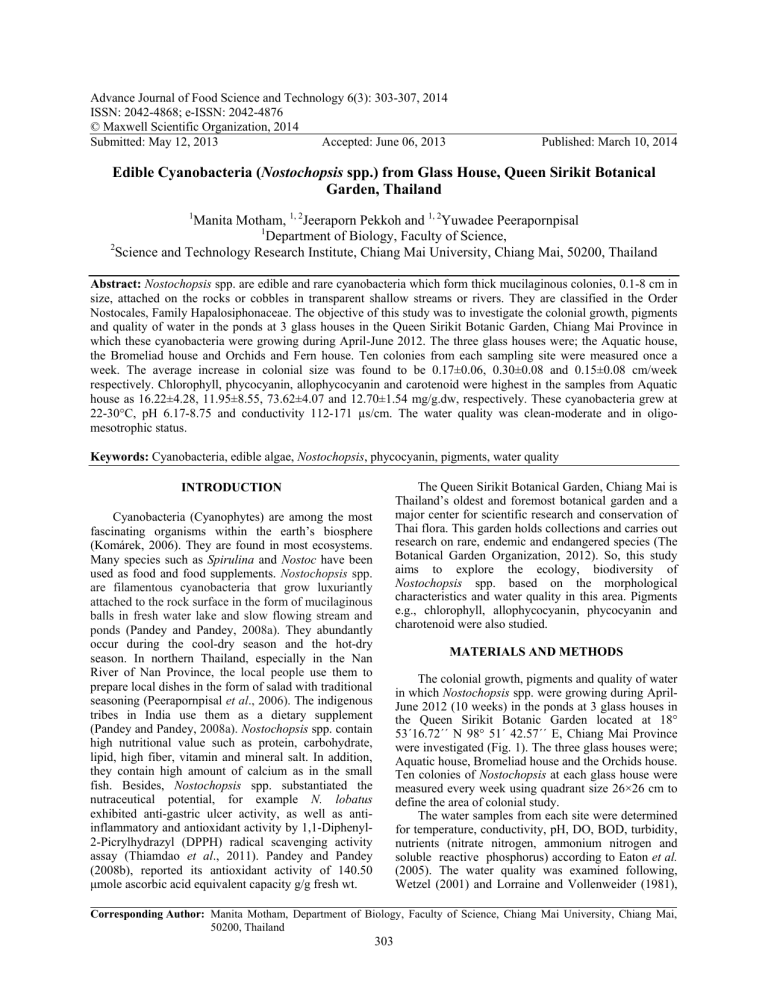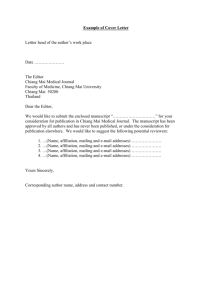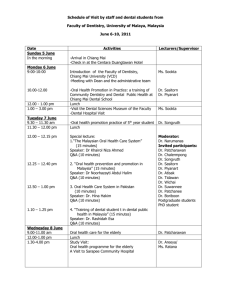Advance Journal of Food Science and Technology 6(3): 303-307, 2014

Advance Journal of Food Science and Technology 6(3): 303-307, 2014
ISSN: 2042-4868; e-ISSN: 2042-4876
© Maxwell Scientific Organization, 2014
Submitted: May 12, 2013 Accepted: June 06, 2013 Published: March 10, 2014
Edible Cyanobacteria (Nostochopsis spp.) from Glass House, Queen Sirikit Botanical
Garden, Thailand
1
Manita Motham,
1, 2
Jeeraporn Pekkoh and
1, 2
Yuwadee Peerapornpisal
1
Department of Biology, Faculty of Science,
2
Science and Technology Research Institute, Chiang Mai University, Chiang Mai, 50200, Thailand
Abstract: Nostochopsis spp. are edible and rare cyanobacteria which form thick mucilaginous colonies, 0.1-8 cm in size, attached on the rocks or cobbles in transparent shallow streams or rivers. They are classified in the Order
Nostocales, Family Hapalosiphonaceae. The objective of this study was to investigate the colonial growth, pigments and quality of water in the ponds at 3 glass houses in the Queen Sirikit Botanic Garden, Chiang Mai Province in which these cyanobacteria were growing during April-June 2012. The three glass houses were; the Aquatic house, the Bromeliad house and Orchids and Fern house. Ten colonies from each sampling site were measured once a week. The average increase in colonial size was found to be 0.17±0.06, 0.30±0.08 and 0.15±0.08 cm/week respectively. Chlorophyll, phycocyanin, allophycocyanin and carotenoid were highest in the samples from Aquatic house as 16.22±4.28, 11.95±8.55, 73.62±4.07 and 12.70±1.54 mg/g.dw, respectively. These cyanobacteria grew at
22-30°C, pH 6.17-8.75 and conductivity 112-171 µs/cm. The water quality was clean-moderate and in oligomesotrophic status.
Keywords: Cyanobacteria, edible algae, Nostochopsis , phycocyanin, pigments, water quality
INTRODUCTION
Cyanobacteria (Cyanophytes) are among the most fascinating organisms within the earth’s biosphere
(Komárek, 2006). They are found in most ecosystems.
Many species such as Spirulina and Nostoc have been used as food and food supplements. Nostochopsis spp. are filamentous cyanobacteria that grow luxuriantly attached to the rock surface in the form of mucilaginous balls in fresh water lake and slow flowing stream and ponds (Pandey and Pandey, 2008a). They abundantly occur during the cool-dry season and the hot-dry season . In northern Thailand, especially in the Nan
River of Nan Province , the local people use them to prepare local dishes in the form of salad with traditional seasoning (Peerapornpisal et al ., 2006).
The indigenous tribes in India use them as a dietary supplement
(Pandey and Pandey, 2008a). Nostochopsis spp. contain high nutritional value such as protein, carbohydrate, lipid, high fiber, vitamin and mineral salt. In addition, they contain high amount of calcium as in the small fish. Besides, Nostochopsis spp. substantiated the nutraceutical potential, for example N. lobatus exhibited anti-gastric ulcer activity, as well as antiinflammatory and antioxidant activity by 1,1-Diphenyl-
2-Picrylhydrazyl (DPPH) radical scavenging activity assay (Thiamdao et al ., 2011). Pandey and Pandey
(2008b), reported its antioxidant activity of 140.50
μmole ascorbic acid equivalent capacity g/g fresh wt.
The Queen Sirikit Botanical Garden, Chiang Mai is
Thailand’s oldest and foremost botanical garden and a major center for scientific research and conservation of
Thai flora. This garden holds collections and carries out research on rare, endemic and endangered species (The
Botanical Garden Organization, 2012). So, this study aims to explore the ecology, biodiversity of
Nostochopsis spp. based on the morphological characteristics and water quality in this area. Pigments e.g., chlorophyll, allophycocyanin, phycocyanin and charotenoid were also studied.
MATERIALS AND METHODS
The colonial growth, pigments and quality of water in which Nostochopsis spp. were growing during April-
June 2012 (10 weeks) in the ponds at 3 glass houses in the Queen Sirikit Botanic Garden located at 18°
53´16.72´´ N 98° 51´ 42.57´´ E, Chiang Mai Province were investigated (Fig. 1). The three glass houses were;
Aquatic house, Bromeliad house and the Orchids house.
Ten colonies of Nostochopsis at each glass house were measured every week using quadrant size 26×26 cm to define the area of colonial study.
The water samples from each site were determined for temperature, conductivity, pH, DO, BOD, turbidity, nutrients (nitrate nitrogen, ammonium nitrogen and soluble reactive phosphorus) according to Eaton et al.
(2005). The water quality was examined following,
Wetzel (2001) and Lorraine and Vollenweider (1981),
Corresponding Author: Manita Motham, Department of Biology, Faculty of Science, Chiang Mai University, Chiang Mai,
50200, Thailand
303
Adv. J. Food Sci. Technol., 6(3): 303-307, 2014
Fig.
1: Sampling sites at queen sirikit botanical garden chiang mai the Guidelines of Standard Surface Water Quality of
Thailand (Notification of the National Environmental
Board, 1994) and AARL PC-Score (Peerapornpisal et al ., 2004; Leelahakrjiengkrai and Peerapornpisal,
2011).
The cyanobacterial samples were taken off their substrates and preserved in 2.0% formaldehyde in plastic boxes at low temperatures (0-4°C). For morphological analysis, cell dimensions: length and
Phycocyanin and allophycocyanin according to
González-Delgadoa and Kafarov (2012) were determined by adding 5 mL 0.15 M NaCl to 0.05 g dried sample kept at 4°C for 24 h and thawed at room temperature. The mixture was ultra-sonicated for 1 min at 6 kHz (Sonic Vibra cellTM) and centrifuged at 3500 rpm for 15 min. The pigments were measured at 620 and 650 nm by the equation:
Phycocyanin � mg g dw
� =
(A
620
− 0.7)× A
7.38
− 10 − 3
650 width of the vegetative cells and diameter of heterocysts were measured. Type of branching was also determined. Samples were identified following the procedures indicated in the relevant books and publications (Bharadwaja, 1934; Desikachary, 1959;
Anagnostidis and Komárek, 1988; Gugger and
Hoffmann, 2004), Photographs of each species were taken using a Light Olympus Normaski Microscope.
Chlorophyll, were determined from dried samples according to Becker (1994). For chlorophyll 10 mL
90% vlv methanol was added to 0.05 g of dried sample and incubated at 70°C for 5 min. The mixture was centrifuged at 3500 rpm for 15 min and the supernatant was measured at 650 and 665 nm. The chlorophyll
(mg/g dw) was determined by the equation:
Chlorophyll a and b (mg/g.dw) = (4.0×A
665
) -
(25.5×A
650
)
Allophycocyanin
Carotenoid was measured according to KMUTT
(2001); by adding 10 mL of ethanol and 60% KOH to
15 mg of dried sample. The mixture was incubated at
50°C for 5 min and centrifuged at 3500 rpm for 10 min.
The supernatant was added with 2 mL of ethanol and 20 mL of diethyl ether and 20 mL of 9% NaCl. The mixture was shaken and the green supernatant was discarded. The yellow supernatant was added with 20 mL of 9% NaCl and 0.05 mg of Na
2
SO
4
. Diethyl ether was then added to give a final volume of 25 mL. The amount of carotenoid was measured at 450 nm following the equation:
� mg g dw
� =
(A
650
− 0.19)× A
5.65
− 10 − 3
620
304
Carotenoid mg g.dw
Adv. J. Food Sci. Technol., 6(3): 303-307, 2014
=
OD
420
× 25×100
260×mg of dried Weight
(Table 1). N. lobata in the Bromeliad House grew better than that in the Orchids and Fern House since the
RESULTS AND DISCUSSION
Colonies of Nostochopsis sp., were soft 0.2-3.5 cm in diameter (Fig. 2), blue-green, filaments with blue green branches (T-branching) which were found at the
Aquatic house and N. lobata Wood ex Bornet et
Flahault colonies were solid at young stage and hollow at the older stage, blue green or olive green, slightly
Bromeliad House was more transparent and got more sunshine than other glass houses (2,850 µmoles/m
2
/s).
Orchids and Fern house was shady (294.5
µmoles/m
2
/s), Both glass houses were found to be non significantly (p>0.05) low in nutrient. Colonies of
N. lobata grown for 8 weeks broke from the rock.
Desikachary (1959) reported that N. lobata attached at first, later became free-floating with erect filaments brown. Blue-green filaments, commonly branched, (Tbranching) were found at the Bromeliad House and
Orchids and Fern House (Fig. 3). They were attached to rocks in the artificial ponds, which corresponded to the surrounded with soft diffluent sheath. Moreover, mucilaginous colonies of Nostochopsis sp., at Aquatic houses the formed thick, 8 cm in diameter which were bigger than previously reported in Thailand previous report by Desikachary (1959) who found
N. lobata in standing or running water, attached or free floating, in paddy-fields, ponds, streams, on rocks in rivers in India and Tanuggyi Canals and in Royal lakes
(Peerapornpisal et al ., 2006; Thiamdao et al ., 2011). In addition, the water quality in all sampling sites was moderate. The pH varied from 6.17 to 8.75. The water temperature at the sampling sites ranged from 24in Burma. Colonial growth of Nostochopsis
Aquatic house was 0.14+0.05 cm/week, sp., in the
N. lobata in the
Bromeliad House and Orchids and Fern House was
0.25+0.03 and 0.14+0.03 cm/week respectively
30.5°C. The water was clear (1-32 NTU) and had low conductivity at 112-171 µs/cm. The Bromeliad house showed the high level of Biochemical Oxygen Demand
(BOD
R
5
R
) at 2.2 mg/L with low nutrients at all sampling
Fig. 2: Different colonies of Nostochopsis spp
Fig. 3: Filaments of Nostochopsis spp. in the ponds of three glass houses, (a) Nostochopsis sp., at aquatic house, (b) N. lobata wood ex bornet et flahault at bromeliad house, (c) N. lobata wood ex bornet et flahault at orchids and fern house; scale bar = 20 µm
Table 1: Growth of Nostochopsis spp. colonies (mm) in each week
Observation sites/time
Aquatic house
Mean 0.14±0.05
Bromeliad house
Mean 0.25±0.03
Orchids and fern house
Mean 0.14±0.03
21 April
-28 April
28 April
-5 May
5 May
-12 May
12 May
-19 May
19 May
-26 May
26 May
-2 June
2 June
-9 June
0.21±0.01 0.28±0.04 0.02±0.06 0.06±0.02 0.13±0.03 0.16±0.09 0.17±0.08
0.30±0.03 0.30±0.02 0.05±0.02 0.09±0.02 0.38±0.02 0.20±0.04 0.23±0.04
0.30±0.02 0.12±0.04 0.04±0.02 0.07±0.03 0.07±0.01 0.20±0.04 0.20±0.03
9 June
-16 June
0.10±0.03
0.26±0.05
0.14±0.07
16 June
-23 June
0.18±0.07
0.38±0.03
0.14±0.01
23 June
-30 June
0.13±0.02
0.35±0.02
0.14±0.01
305
Adv. J. Food Sci. Technol., 6(3): 303-307, 2014
Fig. 4: Physical-chemical factors of water in the three glass houses, (a) conductivity; (b) dissolved oxygen; (c) biochemical oxygen demand; (d) soluble reactive phosphorus, (e) nitrate-nitrogen, (f) ammonium-nitrogen
: Aquatic house; : Bromeliad house; : The orchids and fern house
Table 2: Pigments of Nostochopsis spp. in ponds of three glass house
Pigments/samples
Chlorophyll
Phycocyanin
Allophycocyanin
Carotenoid
Aquatic house (mg
16.22±4.28
a
11.95±8.55
a
73.62±4.07
ac
12.70±1.54
a
/ g.dw) Bromeliad house (mg / g.dw)
12.04±5.42
ab
10.07±8.33
a
53.74±2.07
12.20±0.31
b a
Orchids and fern house (mg
5.24±1.44
b
5.15±1.97
a
5.35±1.00
b
46.32±6.17
b
/ g.dw)
Data are expressed as the mean±Standard Deviation (S.D.) of three replicates; different letters represent the statistical comparisons between groups in each column by using ANOVA and post hoc Tukey’s b test (p<0.05) sites and all the time (Fig. 4). Similarly, water quality was moderate at the Nan River (Peerapornpisal et al .,
2006) and N. lobata grew in non-polluted creeks, rivers and streams (Komárek and Hauer, 2013). Nostochopsis sp., at Aquatic house showed significantly (p<0.05) highest allophycocyanin at 73.62±4.07 mg/g.dw but not difference significant in chlorophyll and carotenoid from N. lobata . Phycocyanin was not significant different between Nostochopsis sp. and N. lobata.
(Table 2). Pandey and Pandey (2008b) reported that,
N. lobata showed potentially high production of biomass, chlorophyll and carotenoids with significant improvement under immobilized cell culture when 10 mg/L K
R
2
R
HPO
R
4
R
was added. Moreover, when 3 mg/L
FeNH
R
4
R citrate was supplemented phycocyanin, phycoerythrin, nutritive value and antioxidant capacity were also higher.
CONCLUSION
Two species of the edible cyanobacteria;
Nostochopsis sp. and N. lobata were found at the glasshouses of Queen Sirikit Botanical Garden, attached on rocks and free floating in standing water with slowly flowing clean-moderate water quality.
These species showed potential production of pigments; chlorophyll, phycocyanin, allophycocyanin and carotenoid which have nutritional value.
ACKNOWLEDGMENT
This study was financially supported by the
National Research Council of Thailand (NRCT), the
King Prajadhipok and Queen Rambhai Barni Memorial
Foundation and The Graduate School of Chiang Mai
306
Adv. J. Food Sci. Technol., 6(3): 303-307, 2014
University. Thanks to Queen Sirikit Botanical Garden,
Chiang Mai for providing collection sites of cyanobacteria in this study.
REFERENCES
Anagnostidis, K. and J. Komárek, 1988. Modern approach to the classification system of cyanophytes 3-oscillatoriales. Algol. Stud., 50-53:
327-472.
Becker, E.W., 1994. Microalgae: Biotechnology and
Microbiology. Cambridge University Press, Great
Britain.
Bharadwaja, Y., 1934. A new species of Nostochopsis
Nostochopsis radians sp. Nov. New Phyt., 33: 1-7.
Desikachary, T.V., 1959. Phycology. Pyarelal Sah at the Times of India Press, Bombay.
Eaton, A.D., L.S. Clessceri, E.W. Rice and
A.E. Greenberg, 2005. Standard Methods for the
Examination of Water and Wastewater. American
Water Association, Virginia.
González-Delgadoa, Á.D. and V. Kafarov, 2012.
Microalgae based biorefinery: Evaluation of several routes for joint production of biodiesel, chlorophylls, hycobiliproteins, crude oil and reducing sugars. Cet., 29: 607-612.
Gugger, M.F. and L. Hoffmann, 2004. Polyphyly of true branching cyanobacteria (stigone matales). Int.
J. Syst. Evol. Microbiol., 54: 349-357.
KMUTT, 2001. Laboratory Instruction: A Workshop on
Mass Cultivation of Spirulina . King Mongkut's
University of Technology Thonburi, Bangkok, pp:
78-93.
Komárek, J., 2006. Cyanobacterial taxonomy: Current problems and prospects for the integration of traditional and molecular approaches. Algae, 21(4):
349-375.
Komárek, J. and T. Hauer, 2013. The on-line database
Lorraine, L.J. and R.A. Vollenweider, 1981. Summer
Report: The OECD Cooperation Program on
Eutrophication. National Water Research Institute,
Burlington, pp: 133.
Notification of the National Environmental Board,
1994. The Enhancement and Conservation of
National Environmental Quality Act B.E.2535
(1992). The Royal Government Gazette, Bangkok.
Pandey, U. and J. Pandey, 2008a. Enhanced production of biomass, pigments and antioxidant capacity of a nutritionally important cyanobacterium
Nostochopsis lobatus
4520-4523. alga
32: 71-76.
. Biore. Techno., 99:
Pandey, U. and J. Pandey, 2008b. Enhanced production of highquality biomass, δ aminolevulinic acid, bilipigments and antioxidant capacity of a food
Nostochopsis lobatus.
Biotechnol., 150: 221-231.
Appl. Biochem.
Peerapornpisal, Y., D. Amornledpison, C. Rujjanawat,
K. Ruangrita and D. Kanjanapothi, 2006. Two endemic species of macroalgae in Nan River, northern Thailand, as therapeutic agents. Sci. Asia.,
Peerapornpisal, Y., C. Chaiubol, H. Kriabut,
M. Chorum, P. Wannathong, N. Ngernpat,
K. Jusakul, A. Thammathiwat, J. Chuananta and
T. Inthasotti, 2004. The monitoring of water quality in Ang Kaew reservoir of Chiang Mai
University by using phytoplankton as bioindicator from 1995-2002. Chiang Mai. J. Sci., 31: 85-94.
The Botanical Garden Organization, 2012. Thailand.
The Botanical Garden Organization Ministry of
Natural Resources and Environment. Retrieved from: www.qsbg.org (Accessed on: January 10,
2012).
Thiamdao, S., M. Motham, J. Pekkoh, L. Mungmai and
Y. Peerapornpisal, 2011. Nostochopsis lobatus
Wood em. Geitler (Nostocales), Edible algae in of cyanobacterial genera. Retrieved from: http://www.cyanodb.cz/ Nostochopsis . (Accessed on: March 04, 2013)
Leelahakrjiengkrai, P. and Y. Peerapornpisal, 2011.
Water quality and trophic status in main rivers of
Thailand. Chiang Mai J. Sci., 38: 001-015. northern Thailand. Chiang Mai. J. Sci., 39:
001-009.
Wetzel, R.E., 2001. Limnology, Lake and River
Ecosystem. Academic Press, New York, pp: 860.
307



